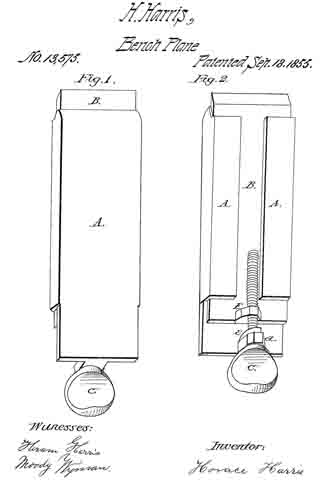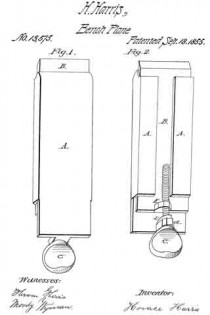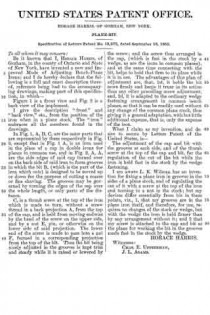
| PLEASE NOTE: The images presented on this page are of low resolution and, as a result, will not print out very well. If you wish to have higher resolution files then you may purchase them for only $2.95 per patent by using the "Buy Now" button below. All purchases are via PayPal. These files have all been cleaned up and digitally enhanced and are therefore suitable for printing, publication or framing. Each zip package contains all the images below (some packages may contain more), and purchased files can be downloaded immediately. |
UNITED STATES PATENT OFFICE.
_________________
HORACE HARRIS, OF GORHAM, NEW YORK.
PLANE-BIT.
_________________
Specification of Letters Patent No. 13,575, dated September 18, 1855.
_________________
To all whom it may concern:
Be it known that I, HORACE HARRIS, of Gorham, in the county of Ontario and State of New York, have invented a new and Improved Mode of Adjusting Bench-Plane Irons; and I do hereby declare that the following is a full and exact description thereof, reference being had to the accompanying drawings, making part of this specification, in which —
Figure 1 is a front view and Fig. 2 is a back view of the implement. I give the description “front” and “back view,” etc., from the position of the iron when in a plane stock. The “iron” embraces all the members found in the drawings.
In Fig. 1, A, B, C, are the same parts that are represented by them respectively in Fig. 2, except that in Fig. 1 A, is an iron used in the place of a cap in double irons for planes in common use, and in Fig. 2, A, A, are the side edges of said cap turned over on the back side of said iron to form grooves in which the bit B, (which is the part of the iron which cuts) is designed to be moved up or down for the purpose of cutting a coarse or line shaving. The grooves may be governed by turning the edges of the cap over the whole length, or only parts of the distance.
C, is a thumb screw at the top of the iron which is made to turn, without a screw thread in a back projection A, from the top of the cap, and is held from moving endwise by the head of the screw on the upper side, and by a nut E, pin, or otherwise on the lower side of said projection. The lower end of the screw is made to pass into a nut F, formed in a corresponding projection from the top of the bit. Thus the bit being nicely adjusted in the grooves is kept trim and steady while it is raised or lowered by the screw; and the screw thus arranged in the cap, (which is fast in the stock by a wedge, as are the irons in common planes), and at the same time connecting with the bit, helps to hold that firm to its place while it is in use. The advantages of this plan of adjustment are, that, 1st, it holds the bit more firmly and keeps it truer in its action than any other preceding screw adjustment, and, 2d, it is adapted to the ordinary wedge fastening arrangement in common bench planes, so that it can be readily used without any change of the common plane stock, thus giving it a general adaptation, with but little additional expense, that is, only the expense of the iron.
What I claim as my invention, and desire to secure by Letters Patent of the United States, is —
The adjustment of the cap and bit with the grooves at each side, and of the thumb screw at the top of the cap and bit, for the regulation cf the cut of the bit while the iron is held fast in the stock by the wedge fastening.
I am aware L. K. Wilman has an invention for fixing a plane iron in grooves in the sides of a plane stock, and of regulating the out of it with a screw at the top of the iron and turning in a nut in the stock; but my devices differ essentially from his in these points, viz., 1, that my grooves are in the plane iron itself, and therefore, for use, requires no changes of the stock or wedge, but with the wedge the iron is held firmer than by any arrangement without it; and 2 that my screw is attached to the cap and bit as the plane for working the bit in the grooves made fast in the stock by the wedge.
HORACE HARRIS.
Witnesses:
CHAS. E. UPPERMAN,
J. L. ADAMS.


